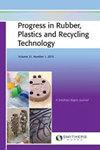设计实验,比较再加工与熔融沉积成型打印参数对循环经济聚乳酸样品力学性能的影响
IF 1.6
4区 材料科学
Q4 MATERIALS SCIENCE, COMPOSITES
Progress in Rubber Plastics and Recycling Technology
Pub Date : 2022-12-12
DOI:10.1177/14777606221145702
引用次数: 1
摘要
增材制造分布式回收是一种促进循环经济的闭环材料再加工解决方案。在DRAM工艺的不同阶段,存在一些与材料特性和回收周期相关的文献空白。为了填补这些空白,通过比较后处理周期(回收)的影响与FDM打印参数(如光栅角方向,填充密度和挤出温度)的影响,通过这项工作做出了小小的贡献。这四个参数是根据它们对聚乳酸(PLA)狗骨试件拉伸性能的影响进行排序的。采用田口分析法设计实验,避免了大量样本的分析。结果表明:循环利用对PLA样品的拉伸性能影响最大,在4次循环处理过程中拉伸强度降低高达75%;试样的极限抗拉强度(UTS)在第一次处理循环时为20 ~ 26 MPa,在第4次处理循环后显著下降至7 ~ 9 MPa。此外,还对每个再加工阶段的时间和3D打印样本数量进行了新颖的分析,以帮助未来的研究人员管理他们的打印时间表,特别是在回收领域。本文章由计算机程序翻译,如有差异,请以英文原文为准。
Design of experiments to compare the reprocessing effect with Fused Deposition Modeling printing parameters on mechanical properties of Polylactic Acid specimens towards circular economy
Distributed Recycling via Additive Manufacturing (DRAM) is a closed-loop material reprocessing solution that promotes circular economy. There are several literature gaps related to material properties and recycling cycles at different stages of the DRAM process. With an approach to filling these gaps, a small contribution has been made through this work by comparing the effect of reprocessing cycles (recycling) with the effect of FDM printing parameters such as Raster angle orientation, Infill density and Extrusion Temperature. These four parameters are ranked based on their impact on the tensile properties of Polylactic Acid (PLA) dog bone specimens. The Design of Experiments via Taguchi Analysis is carried out to avoid analysis of a large number of samples. The results show that recycling has the maximum impact on the tensile properties of PLA samples and can reduce the tensile strength by up to 75% in the course of four reprocessing cycles. The specimens had Ultimate Tensile Strength (UTS) values in the range of 20–26 MPa at the first reprocessing cycle which dropped significantly to a range of 7–9 MPa after the fourth reprocessing cycle. Additionally, a novel analysis on time and the number of specimens to be 3D printed at each reprocessing stage has also been conducted to help future researchers manage their printing schedule, especially in the recycling domain.
求助全文
通过发布文献求助,成功后即可免费获取论文全文。
去求助
来源期刊

Progress in Rubber Plastics and Recycling Technology
MATERIALS SCIENCE, COMPOSITES-POLYMER SCIENCE
CiteScore
4.40
自引率
7.70%
发文量
18
审稿时长
>12 weeks
期刊介绍:
The journal aims to bridge the gap between research and development and the practical and commercial applications of polymers in a wide range of uses. Current developments and likely future trends are reviewed across key areas of the polymer industry, together with existing and potential opportunities for the innovative use of plastic and rubber products.
 求助内容:
求助内容: 应助结果提醒方式:
应助结果提醒方式:


